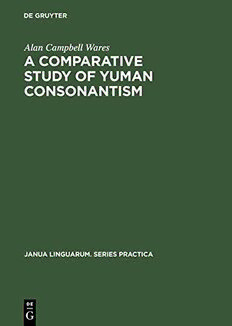
A Comparative Study of Yuman Consonantism PDF
Preview A Comparative Study of Yuman Consonantism
A COMPARATIVE STUDY OF YUMAN CONSONANTISM JANUA LINGUARUM STUDIA MEMORIAE NICOLAI VAN WIJK DEDICATA edenda curat C. H. VAN SCHOONEVELD INDIANA UNIVERSITY SERIES PRACTICA 57 0J 1968 MOUTON THE HAGUE · PARIS A COMPARATIVE STUDY OF YUMAN CONSONANTISM by ALAN CAMPBELL WARES SUMMER INSTITUTE OF LINGUISTICS m 1968 MOUTON THE HAGUE · PARIS © Copyright 1968 in The Netherlands. Mouton & Co. Ν.V., Publishers, The Hague. No part of this book may be translated or reproduced in any form, by print, photoprint, microfilm, or any other means, without written permission from the publishers. LIBRARY OF CONGRESS CATALOG CARD NUMBER 68-15540 Printed in the Netherlands by Mouton & Co., Printers, The Hague. PREFACE This study has grown out of a routine linguistic survey that was made in 1953 to determine the number and size of Indian groups in the northern region of Lower California. Word lists that were made at that time were filed away and almost forgotten until Werner Winter saw them and urged that they be used for such a study as this. No attempt has been to reconstruct Proto-Yuman forms, and the vocalic system has been treated only briefly, but it is hoped that students of comparative Yuman will find sufficient data here to enable them to arrive at conclusions of their own as regards reconstructed forms. Although I am grateful to a number of individuals — colleagues of the Summer Institute of Linguistics and professors of the University of Texas — for comments and constructive criticism as this study was taking shape, I am especially thankful to Werner Winter, without whose encouragement this may never have been written. In addition, I wish to acknowledge the willing help of my wife, Iris Mills Wares, in the laborious job of proofreading these pages. Mexico City ALAN C. WARES November, 1965 CONTENTS Preface 5 I. The Yuman Family of Languages 9 II. Sources of Language Data 19 III. General Features of Yuman Languages 22 IV. The Phonemes of Walapai 27 V. The Phonemes of Mohave 31 VI. The Phonemes of Maricopa 35 VII. The Phonemes of Cocopa 37 Vili. The Phonemes of Diegueño 39 IX. The Phonemes of Tipai 41 X. The Phonemes of Paipai 43 XI. The Phonemes of Kiliwa 46 ΧΠ. Classification of Yuman Languages 49 XIII. Proto-Yuman Phonology 53 XIV. Comparative Yuman Vocabulary 77 Bibliography 97 Territory of Yuman Tribes I. THE YUMAN FAMILY OF LANGUAGES The Yuman Indian languages are spoken by a group of tribes scattered over an area approximately 400 miles long from north to south, and 300 miles wide. The limits of this area are the Grand Canyon in northern Arizona on the north and the Valley of the Trinity in Lower California on the south; the vicinity of San Diego, California, on the west and the Mescal Mountains of Arizona on the east. Formerly the territory covered by the Yuman tribes extended farther into the Lower California peninsula, but the southern boundary has receded as tribes have become extinct or have merged into the Mexican mestizo culture.1 Since the present work is based largely on contem- porary data, only a passing reference will be made to these and other which have lost their identity through assimilation or extinction. The designation "Yuman" as applied to these tribes comes from the term "Yuma" which was given to one of the tribes of this group by the Spanish explorers and possibly at an earlier time by the Pima and Papago. Swanton ascribes it to the Pima and Papago in the first place,2 but Forde raises the question as to whether the name origi- nated with the Pima and Papago or with the Spaniards.3 The Yumas call themselves /kwacá-n/, a name analyzed as meaning "those who descend (in a group)".4 According to Halpern, their present-day speech community is not differentiated dialectically.6 The territory occupied by this tribe is described by Swanton as being "on both sides 1 Gifford, Edward Winslow, The Cocopa (UCPAAE, 1933), p. 257. 4 Swanton, John R., The Indian Tribes of North America (BAE, 1952), p. 369. * "The origin of the term Yuma is doubtful. The statements that it was derived from terms for 'son of the chief' or 'sons of the river', were always improbable and have been disproved by inquiries. Ten Kate was informed by the Pima that their native name for the Yuma was Yum. This was con- firmed by A. L. Pinart, a resident among the Papago, in a letter to Gatschet in which he stated that the Pima would call both a Yuma and a Comoye'i (Kamia and (?) Diegueño) man i'um o'otam; the Papago, according to his information, call both the Yuma and the Maricopa 'yum' while an 'Apache- Mohave' (Yavapai) whom he questioned also used the term 'Yum' and did not know the term 'kutcha'n'. Heintzleman, 1854, apparently used the word 'Yum' in reference to the Kamya alone ('New River Indians'), calling the Yuma 'Kuchan'. Without some investigation of the occurrence and associations of the term 'Yum' among the Pima, Papago, and other tribes, the question cannot, however, be considered settled. The Spaniards were already using the term Yuma in the eighteenth century and it still remains possible that they introduced it among the Pima and others where it supplanted earlier usage." Forde, C. Daryll, Ethnography of the Yuma Indians (UCPAAE, 1938), p. 89. 4 Halpern, Abraham M., "Yuma" in I J AL, 13 (1947), p. 105. 1 UAL, 12 (1946), p. 25.
